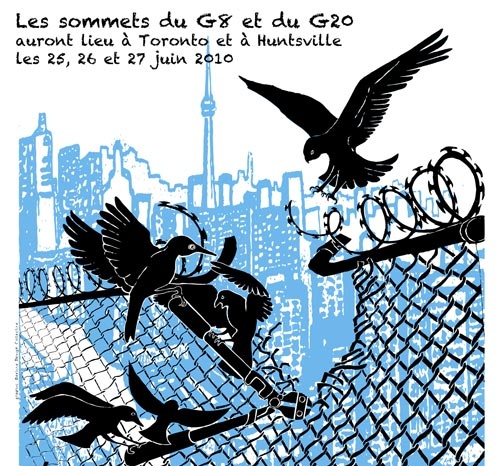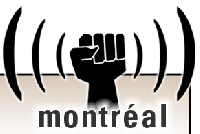 |
 |
 |
 |
 |
 |
|
 |
 |
 |
 |
 |
 |
 |
Régions du Québec |  |
 |
 |
|
 |
 |
|
 |
 |
|
 |
 |
 |
 |
 |
 |
Rubriques (sujets) |  |
 |
 |
|
 |
 |
|
 |
|
 |
 |
 |
Reflection and Synopsis of the Events in Québec City
Brief reflection of the events and chronology of the weekend as seen by a student observing the protest
Québec City left most with a new understanding of many things. Some returned from Québec with new and different ideas about the legitimacy of democracy and its leaders in our country and our hemisphere today. For others, the Québec summit came to symbolise what is possible when the people of a hemisphere decide that they want to make a difference against their increasingly American and corporate dominated lives. For still others, it served and a learning experience for the importance of solidarity and of knowledge by the people in order to take back what they feel is rightfully theirs.
Thousands of people from all over the world came to Québec to protest, each with their own reasons. Many feared that the Free Trade Area of the Americas (FTAA) would bring the entire hemisphere into the horror of the current North American Free Trade Agreement (NAFTA). Some of these fears were of the controversial Chapter 11 in the NAFTA agreement. This clause allows corporations to bring lawsuits against national governments for taking actions and passing laws, which would inhibit trade and reduce profits. It was originally included to protect against nationalisation of industries, but has become abused by corporations ever since it was adopted. Under the NAFTA agreement, this abuse has occurred many times already. One of the best known was a case brought by the American company EthylCorp, against the Canadian Government for its law prohibiting a gasoline additive methyl-tert-butyl-ether (MTBE), which was found to be carcinogenic. Other fears were that corporations would be able to disregard environmental, labour and human rights laws in the interests of profits.
For those who participated in the protest or who were just there to observe, there were many ways to become involved. Protesters and marchers ranged from the more violent La Convergence des luttes anti-capitalistes (CLAC), to the generally more peaceful Council of Canadians, organised labour movements and countless other organisations and groups in between, representing everything one could imagine.
The protest officially began on the around noon of Friday the 20th of April with a march beginning at Université Laval in Saint - Foy, where many of the protesters were living and ending in the downtown of the city on Boulevard Charest - Est. The march was peaceful and considered "green" by the organising system set up. All throughout the march cheers and chants could be heard from all around. Among them were phrases such as; "Le peuple, uni, jamais ne sera vaincu", "Dans la rue, avec nous" and "So, so, so, solidarité" amongst countless others, one could hardly help being caught up in the excitement and the power of the moment.
Many decided to go to the security perimeter to protest peacefully by dancing and playing musical instruments before lines of baton carrying riot police of the Sûreté du Québec, while others favoured a more direct confrontation with the police. At about mid-afternoon on the 20th in the area of Boulevard René Lévesque, a protester climbed atop the security fence. As the police pulled him down, about 20 metres of the fence came with him. This event symbolised for many the ability of the people to be heard and not be left out. The police immediately responded with tear gas canisters and a series of baton charges in order to regain control of the perimeter.
In another area of the perimeter, the police used tear gas to disperse protesters peacefully conducting a circle dance by Rue Richelieu. At first the police were very laid back and non-confrontational, but later on as people decided to throw themselves onto the fence separating the police from the protesters, tear gas began to be used in quick doses in the afternoon and later escalating to canisters in the evening. Eventually the police told the protesters to disperse because water cannon were coming from one direction and a baton charge by more riot police from the other. The water cannon and baton charge never came but later on in the night the police behind the fence moved to the other side and slowly tried to push the protesters away. Clashes with the police continued throughout the night and into the next morning.
By the end of the afternoon, it was impossible to travel anywhere within 250 metres of the perimeter without being affected by the tear gas. For those in the midst of the gas, eyes began to burn and tear, sometimes it was impossible to keep one's eyes open because of the pain; breathing became difficult because of pain in the throat and in the nose. The feeling could be compared to inhaling large amounts of chilli pepper and throwing Tabasco sauce in the eyes. Many protesters used scarves soaked in lemon juice to reduce the effects of the gas; others could be seen pouring up to one litre of water in their eyes in some cases in order to wash out the gas.
The next day, another march was organised to depart from la Musée du Québec and proceed down Rue Salabarry. This march was aimed at being peaceful and organised by labour groups and had no intention of going within the perimeter area. For the most part this occurred and the march was the same as the one the previous day only this time over 30 000 people were involved. Once again the march brought people together but about halfway through, the march split into two groups. One of these groups continued along the planned route while the other went to the perimeter.
All through the day, clashes with the police continued and in some instances resulted in vandalism being committed. In one instance about twenty men dressed in all black decided to break the windows of a CIBC branch. This was seen as unacceptable by most and protesters made it clear to the people involved by chasing them away from the area. The police responded by expanding their line to protect the bank. All day along the perimeter, tear gas canisters flew over the protesters and the smell of tear gas once again returned to the city after a fairly quiet night. This time the gas was stronger and in some cases even laced with pepper spray.
In other areas, the dancing and peaceful protesting continued once again in the face of the tear gas being lobbed in by the police. At one time the police surrounded and area and charged in sending protesters running in all directions trying to flee the tear gas and riot police following them. The sight to an observer could only be described as one of the most terrifying one can experience. The police in their charge ended up sending the people into the area around Boulevard Charest - Est. Throughout the rest of the evening clashes and arrests continued again and the use of tear gas increased because the amount of vandalism increased.
In the aftermath of the protest, on Sunday the 22nd, many of the protesters participated in a Sierra Club of Canada event and scoured the city with plastic bags cleaning up the city. Throughout the morning, workshops were also available for people to attend in order to learn about the issues at hand and what may be in store for the future. People like Elizabeth May, leader of the Sierra Club of Canada came to speak at these workshops. Others decided to attend sessions reflecting on the events of the past two days. This move was seen as a positive end to what some saw as an uncertain weekend.
In the end, the summit was not interrupted in any great way, but the protesters did make their presence known and get their message across. Unfortunately, some chose the route of violence and gave a bad name to those who were trying to get their point across through peaceful means and also nullified any message they were trying to present to the ministers in the summit. Because of the violence, the trade ministers most likely did not take the protesters as seriously as they would have if the violence did not occur. Hopefully, future generations will learn from the mistakes and the successes of those involved in Québec and make better decisions at the Buenos Aires summit in this new light.
 |
 |
 |
 |
Dossier G20 |  |
 |
 |
|
 |
 |
|
 |
Nous vous offrons plusieurs reportages indépendants et témoignages...

Liste des activités lors de ce « contre-sommet » à Toronto Vous pouvez aussi visiter ces médias alternatifs anglophones... Centre des médias Alternatifs Toronto 2010.mediacoop.net Media Co-op Toronto http://toronto.mediacoop.ca Toronto Community Mobilization www.attacktheroots.net (en Anglais) |
 |
 |
 |
 |
 |
 |
 |
CMAQ: Vie associative |  |
 |
 |
|
 |
 |
|
 |
 Collectif à Québec: n'existe plus. Impliquez-vous ! |
 |
 |
 |
 |
 |
 |
 |
 |
|
 |
 |
 |
Ceci est un média alternatif de publication ouverte. Le collectif CMAQ, qui gère la validation des contributions sur le Indymedia-Québec, n'endosse aucunement les propos et ne juge pas de la véracité des informations. Ce sont les commentaires des Internautes, comme vous, qui servent à évaluer la qualité de l'information. Nous avons néanmoins une
Politique éditoriale
, qui essentiellement demande que les contributions portent sur une question d'émancipation et ne proviennent pas de médias commerciaux.
This is an alternative media using open publishing. The CMAQ collective, who validates the posts submitted on the Indymedia-Quebec, does not endorse in any way the opinions and statements and does not judge if the information is correct or true. The quality of the information is evaluated by the comments from Internet surfers, like yourself. We nonetheless have an
Editorial Policy
, which essentially requires that posts be related to questions of emancipation and does not come from a commercial media.


